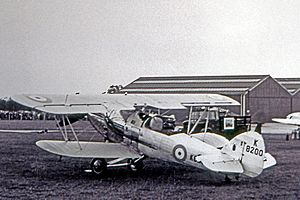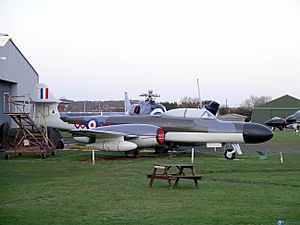No. 64 Squadron RAF facts for kids
No. 64 Squadron was a group of planes and pilots in the Royal Air Force. It first started on 1 August 1916 as part of the Royal Flying Corps. The squadron was eventually closed down on 31 January 1991 at RAF Leuchars.
Quick facts for kids No. 64 Squadron |
|
|---|---|

No. 64 Squadron badge
|
|
| Active | 1 August 1916 - 31 December 1919 1 March 1936 - 16 June 1967 16 May 1968 – 31 January 1991 |
| Country | |
| Branch | |
| Motto(s) | Latin: Tenax propositi ("Firm of purpose") |
| Battle honours | Western Front, 1917-1918 Cambrai, 1918 Amiens, Hindenburg Line, Somme, 1918 Lys, Channel & North Sea, 1940 Dunkirk, Battle of Britain, Home Defence, 1940 Fortress Europe, 1941-1944 Normandy, 1944 Arnhem, Walcheren, France & Germany, 1944-1945 |
| Insignia | |
| Squadron badge heraldry | A scarab |
| Squadron codes | XQ (February to September 1939) SH (September 1939 to April 1951) |
| Squadron roundel |  |
Contents
History of No. 64 Squadron
Early Years: 1916 to 1919
No. 64 Squadron of the Royal Flying Corps started on 1 August 1916 in Sedgeford, Norfolk. At first, they used different types of planes for training. These included the Henry Farmans and Avro 504s.
In June 1917, the squadron got new planes called the Airco DH.5 fighters. They started getting ready for real missions. The DH.5 planes were not good at flying very high. So, the squadron practiced flying low to the ground. They did this before and after moving to France in October 1917.
On 20 November, the British started the Battle of Cambrai (1917). This was a big attack with many tanks. No. 64 Squadron helped the ground troops. They flew many low-level attacks during both the British attack and the German counterattack.
In March 1918, the DH.5s were replaced by SE.5A planes. The squadron continued to fly both fighter and ground-attack missions. They did this for the rest of First World War. The squadron returned to RAF Narborough in February 1919. It was then closed down on 31 December 1919. During World War I, the squadron claimed over 130 victories. They also had eleven pilots who became known as flying aces.
Reforming the Squadron: 1936 to 1939
No. 64 Squadron started up again on 1 March 1936 in Heliopolis, Egypt. They used Hawker Demon two-seat biplane fighters. This was a secret move because Italy had invaded Ethiopia. Britain was worried that the war might spread.
The squadron moved to Ismailia in Egypt in April 1936. If war broke out, their job was to attack Italian airfields. They would also protect bombers refueling at other airfields. By June 1936, Italy had taken over Ethiopia. This ended the risk of war between Britain and Italy. The squadron then moved back to the United Kingdom in August 1936. They became part of the UK's air defenses.
Back in Britain, the squadron was based at RAF Martlesham Heath. From May 1938, their Demon planes were at RAF Church Fenton. The squadron then got new Bristol Blenheim Mk I(F) fighters starting in December 1938. After Second World War began, the squadron flew patrols off the British East Coast. In December 1939, they helped defend the Home Fleet at Scapa Flow for a month.
World War II and Beyond: 1940 to 1967
In April 1940, the squadron switched to Supermarine Spitfire Mk I planes. They immediately helped cover the Dunkirk evacuation. Later, they took part in the famous Battle of Britain. During this time, 64 Squadron moved between many different airfields. These included Kenley, Leconfield, and Biggin Hill.
In May 1941, No. 64 Squadron moved to Scotland to defend the air. But they moved back south in November to fly missions over northern France. They moved back to Scotland again in March 1943. Then, in August 1943, they moved south again to continue their attacks. In June 1944, they moved to Cornwall for two months. After that, they started long-range escort missions from East Anglia.
During this time, the squadron used different versions of the Spitfire. These included the Mk IIA, Mk VB, Mk VC, and Mk IX. In 1944, 64 Squadron took part in important operations. These included the Normandy Landings, Operation Market Garden, and the Battle of the Scheldt.
In November 1944, the squadron received North American Mustang III planes. They flew these for the rest of the war. Their job was to cover daylight bombing raids by the RAF Bomber Command on Germany. After the war ended, the squadron moved to RAF Horsham St Faith. They received the Mustang IV in August 1945.
In March 1946, No. 64 Squadron got De Havilland Hornet F.1 twin-engined fighters. They moved to RAF Linton-on-Ouse in August of that year. The F.1 was replaced by the Hornet F.3 in April 1948. In March 1951, the squadron switched to Gloster Meteor F.4/F.8 jet fighters. The squadron also moved to RAF Duxford. In September 1956, the F.8s were replaced by the Meteor NF.12/NF.14. These were two-seat planes with radar.
In September 1958, 64 Squadron then switched to Gloster Javelin FAW.7/FAW.9 planes. In 1964, the squadron moved to RAF Tengah in Singapore. They worked with No. 60 Squadron RAF. The squadron was closed down on 16 June 1967.
Later Years: 1968 to 1991
After 1967, the squadron became a 'Shadow' or Reserve unit. This meant it was the identity for No. 228 OCU. This unit trained pilots to fly the McDonnell Douglas Phantom FG.1/FGR.2. They first flew from RAF Coningsby starting 16 May 1968. Then they moved to RAF Leuchars on 22 April 1987. When No. 228 OCU was closed down on 31 January 1991, No. 64 Squadron was also closed down for good.
Famous Members of No. 64 Squadron
Some notable people who were part of No. 64 Squadron include:
- Art Donahue
- Squadron Leader/Wing Commander Michel Donnet
- Flying Officer Raymond Sanders Draper
- Adrian Francis Laws
- Wing Commander Dudley Lloyd-Evans
- John Noble MacKenzie
- Jackie Mann
- James O'Meara
No. 64 Squadron in Stories
In episode 2 of the TV show Piece of Cake, it is mentioned that a Bristol Blenheim plane from No. 64 Squadron was accidentally shot down by another squadron.



